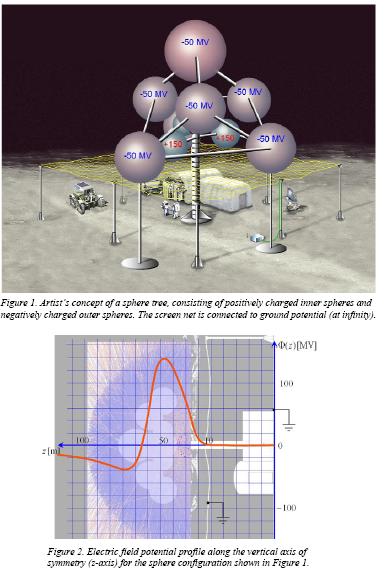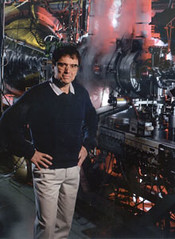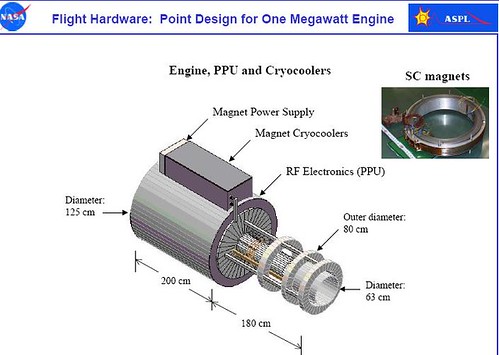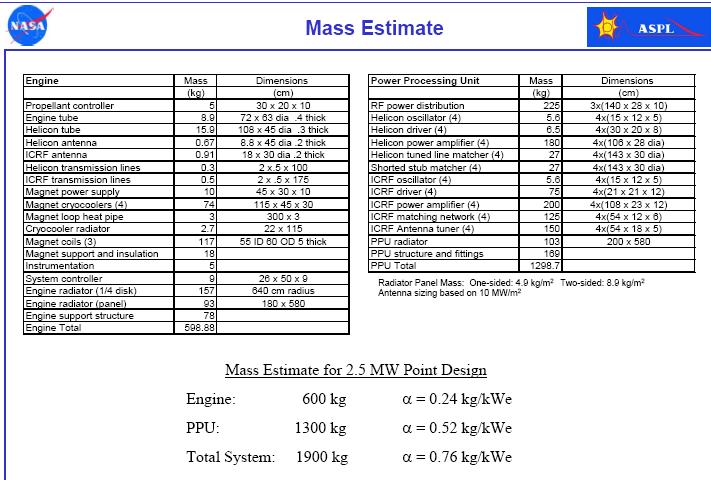A proposed portable nuclear reactor (simplified solid core) is the size of a hot tub and will be able to generate 27MW. It is in funded development. A 200 KW version of the Vasimr engine is being ground tested in 2008 and a flight version is being readied for 2010. Seven of the nuclear generators would provide 200 MW of power to enable 39 day one way trips to Mars. Two technologies that are both in funded development and with no major feasibility questions could revolutionize space travel.
LATEST UPDATE – Clarification about what is novel about this design and what should be the same as other nuclear reactor and nuclear propulsion systems:
The reactor does not exist yet. Therefore, it is not space rated. They have just announced that they are working on it. They are talking 2012 for the first one to get finished for some ground application.
However, it is just another solid core nuclear reactor. I do not see why other nuclear reactor designs and solid core rockets would work and this would not. There have been other nuclear thermal spacecraft designs using similar technology. I am just choosing to pair the reactor with the Vasimr plasma drive instead of using direct nuclear propulsion systems. It is nuclear electric powering a vasimr drive.
The patent indicated that if they used thorium hydrate then the reactor would run at about 1900 degrees, which could be better for nuclear power system for a rocket. However, they are first working on uranium hydrate.
I have not done any detailed design for this system, but there is not that much about it that is that novel compared to other nuclear reactor for space rocket designs. The main novelties – no people needed to tend the nuclear reactor – it keeps a constant temperature by itself – it is simple and presumably easier to build and maintain – less waste than many other systems. Heat piping, radiation shielding, heat radiators, conversion of the steady state heat to electricity are all things that can be tweaked based on the application and which can be cribbed from past nuclear rocket designs. Some other nice things are that they are talking about mass factory production and low costs.
At the rate of power production assumed for the reactor, 50 to 100 W/cm**3.
If the density is 8, then it would seem to work out to 7-14KW per kg.
UPDATING AGAIN:
There are some basic sources online to perform the rough estimates of heat pipe weighting and heat radiators.
Some other component weights for other nuclear rockets.
The hyperion device runs at 400-800 degrees using uranium hydrates and can run at 1900 degrees using thorium hydrates. We can look at other spacecraft designs that have heat radiators. Those are separate technologies from the main hyperion nuclear reactor and the physics of dealing with the heat is the same. The Hyperion reactor’s main advantage is that it self-regulates to whatever temperature range it is designed for based on different metal hydrates that are used. Dealing with heat and electricity conversion is not changed from other solid core nuclear reactors.
ANOTHER UPDATE: I exchanged email with hyperion power systems (the maker of the new power generator. They indicate that the Sante Fe reporter made a mistake. The output is about 25-17 MW ELECTRIC [This statement was also consistent with the patent which talked about tens of MW in electricity. They also said that the containment vessel will be dense enough that no radiation will escape even if it is not buried in the ground.

The proposed nuclear “battery” reactor
UPDATE: For a space craft we would want to eliminate extra weight and especially any dirt radiation shield. There are several approaches. Research has been looking at using lightweight electric and electrostatic fields for radiation shields. We would only need to concentrate shielding on the crew quarters. The crew quarters would probably be in the front with the 600 tons of fuel in fuel tanks between them and the reactors. Shorter trip times mean less exposure to low gravity and cosmic rays.
Spacecraft designers may also use a ship’s own cryogenic fluids as a radiation screen by arranging the cargo tanks containing them around crew compartments.
“In most [mission] scenarios, you need liquid hydrogen for fuel and you need water,” explained Richard Wilkins, director of NASA’s Center for Applied Radiation Research at Prairie View A & M University in Texas, conducting one study into liquid shield approaches. “And these are all considered materials that are particularly good for cosmic ray shielding.”
Here is a 12 page pdf on electrostatic radiation shielding

Another issue is converting heat from the nuclear plant to electricity. There has been a great deal of progress on thermoelectronics. Thermoelectronics are electronics that convert heat into electricity. The thermoelectric effect is discussed at wikipedia
One company Powerchips claims to be able to achieve 70-80% carnot efficiency. This would mean that at 70% carnot efficiency if the hot side was 500 degrees celsius and the cold side was 0 then 45% of the heat would be captured as electricity. If the cold side could get down to -80 or -90 then the effiency would be 54%. The cold side might get that cold or colder in space if it was shaded.
The total critical mass is from 600-1200 kg. The total mass for the nuclear reactor is probably under 100 tons and possibly in the 10-20 ton range. A nuclear powered Vasimr rocket would enable one way trips to Mars in 39 days and delivering 22 tons of payload. Vasimr engines can get up to 50,000 ISP which is 1100 times more fuel efficient than the Space Shuttle. The nuclear space vehicle would weigh about 600-1500 tons fully fulled. So it would take several launches using chemical rockets to put the pieces in orbit for assembly. A slightly scaled back system with one or two nuclear reactors would still enable trip to Mars for 70-100 day trips to Mars.
There is no serious scientific question about whether these two technologies (improved nuclear fission and Vasimr plasma propulsion) will work. It is a matter of funding the work and doing the engineering development.

Franklin Chang Diaz and his 200 kw Vasimr engine

Information on the 200MW Vasimr system and one way travel times to Mars
The VASIMR system is a high power, electrothermal plasma rocket featuring a very high specific impulse (Isp) and a variable exhaust. Its unique architecture allows inflight mission-optimization of thrust and Isp to enhance performance and reduce trip time. VASIMR consists of three major magnetic stages where plasma is respectively injected, heated and expanded in a magnetic nozzle. The magnetic configuration is called an asymmetric mirror. The 1st stage handles the main injection of propellant gas and the ionization subsystem; the 2nd stage acts as an amplifier to further heat the plasma. The 3rd stage is a magnetic nozzle which converts the plasma energy into directed momentum. The magnetic field insulates nearby structures from the high plasma temperature (>1,000,000 oK.) It is produced by high temperature superconductors cooled mainly by radiation to deep space. Some supplemental cooling from the cryogenic propellants ( hydrogen, deuterium, helium or mixtures of these) may also be used.
The system is capable of high power density, as the plasma energy is delivered by wave action, making it electrodeless and less susceptible to component erosion. Plasma production is done in the 1st stage by a helicon discharge, while additional plasma heating is accomplished in the 2nd stage by the process of ion cyclotron resonance.
Another paper analyzing vasimr engines
FURTHER READING
Another nuclear powered vehicle that we have the technology to start building now is the liberty ship a gaseous core nuclear design. It could launch 1000 tons into orbit in one trip and would not leak any nuclear material. This kind of design is needed to greatly improve launching from earth to orbit. The nuclear Vasimr only helps with getting from orbit to anywhere else.
For Mars and beyond, we will need to develop nuclear electric power. If we don’t, we might as well quit. We’re not going to get anywhere without it.
I also would not want to send people to Mars on a fragile and power-limited ship. If you send people that far, you have to give them a fighting chance to survive, and the only way you can do that is if you have ample supplies of power. Power is life in space.
Here is a 47 slide presentation by Tim Glover on a 12MW Vasimr system.

Tim Glover’s presentation shows components that would be needed for high power Vasimr systems like this 4MW ICRF antenna

Size of parts for a 1MW Vasimr engine

2.8 MW RF power converter

The components and weights of a 2.5MW vasimr engine design
This pdf from 2003 surveyed various near term propulsion options for trips to Mars.
If we get fusion power working then we can do even better.
Advertising
Trading Futures
Nano Technology
Netbook Technology News
Computer Software
Future Predictions

Brian Wang is a Futurist Thought Leader and a popular Science blogger with 1 million readers per month. His blog Nextbigfuture.com is ranked #1 Science News Blog. It covers many disruptive technology and trends including Space, Robotics, Artificial Intelligence, Medicine, Anti-aging Biotechnology, and Nanotechnology.
Known for identifying cutting edge technologies, he is currently a Co-Founder of a startup and fundraiser for high potential early-stage companies. He is the Head of Research for Allocations for deep technology investments and an Angel Investor at Space Angels.
A frequent speaker at corporations, he has been a TEDx speaker, a Singularity University speaker and guest at numerous interviews for radio and podcasts. He is open to public speaking and advising engagements.


Comments are closed.